Preface: According to Politico, a new HBO documentary claims to have cracked the true identity of Bitcoin's anonymous creator, Satoshi Nakamoto, but HBO's promotional materials do not explicitly make this claim. The most commonly suspected individuals include the late software engineer Hal Finney, systems engineer Dorian Nakamoto, computer scientist Nick Szabo, and Hashcash inventor Adam Back. However, currently, prediction sites rank Len Sassaman as the top candidate, far ahead of others. Who exactly is Len Sassaman? This article provides a comprehensive description.
We have lost too many hackers who chose to take their own lives. What if Satoshi was one of them?
Embedded in every Bitcoin node is an obituary. This obituary is embedded in the transaction data, serving as a tribute to Len Sassaman—someone who is almost immortalized on the blockchain. This form of commemoration is most fitting.

Len was a true cypherpunk—smart, fearless, and idealistic. He dedicated his life to defending personal freedom through cryptography, participated in the development of PGP encryption and open-source privacy technologies, and studied P2P networks under the guidance of blockchain inventor David Chaum as an academic cryptographer.
He was also a cornerstone of the hacker community: a friend and influencer to many important figures in the history of information security and cryptocurrency.
Losing Satoshi
According to everyone, Len was destined to become one of the most important cryptographers of his time. But on July 3, 2011, after struggling with long-term depression and functional neurological disorders, he tragically ended his life at the age of 31.
His death coincided with the disappearance of the world's most famous cypherpunk—Satoshi Nakamoto. Two months before Len's death, Satoshi sent their last communication:
I have moved on to other things and may not be around for a while.
After making 169 code commits and 539 posts within a year, Satoshi vanished without explanation. They left behind a pile of unfinished features, heated debates about their vision for Bitcoin, and a stash of BTC worth $64 billion that remains untouched to this day.
We have lost too many hackers who chose to take their own lives: Aaron Swartz, Gene Kan, Ilya Zhitomirskiy, James Dolan. They were all victims of a shameful and pervasive epidemic of depression, which has also impacted technological progress itself. Imagine if the creator of Bitcoin had died before completing it. If that were true, what could they have brought to the world if they had received the care and respect they deserved?
I hesitate to speculate on Satoshi's identity because discussions around this topic often range from misleading to absurd, even unethical. However, with Craig Wright falsely claiming to be the creator of Bitcoin, it is necessary to revisit this topic and refocus the discussion on those who truly built Bitcoin—the cypherpunks.
Whoever Satoshi is, they undoubtedly "stood on the shoulders of giants"—Bitcoin is the culmination of decades of research and discussion within the cypherpunk community. In this sense, Len is undoubtedly an indirect contributor. But we still cannot help but ask, who wrote the code, ran the first node, and published content under the pseudonym Satoshi?
To synthesize and realize the many ideas on which Bitcoin is based, that individual or team must possess unique expertise across multiple fields, including public key infrastructure, academic cryptography, P2P network design, practical security architecture, and privacy technologies. They likely had deep roots in the cypherpunk community and close ties to those who significantly influenced cryptocurrency. Ultimately, they needed a steadfast ideological belief and a hacker spirit to "roll up their sleeves" and anonymously build a system in the real world that had previously remained theoretical.
As I reflect on Len's life, I see many of the same qualities. I believe Len may have been one of Bitcoin's direct contributors.
Given the unprecedented attention cryptocurrency is receiving, I hope to raise awareness of those "unsung heroes" we should be grateful for. I also hope we can reflect on the importance of addressing mental illness, especially functional neurological disorders that deserve more attention.
Origins

Even as a young man, Len was a self-taught technical expert focused on cryptography and protocol development. Although he lived in a small town in Pennsylvania, by the age of 18, Len had joined the Internet Engineering Task Force (IETF), which was responsible for the TCP/IP protocol that later became the foundation of the Bitcoin network.
"Always seeming a bit special because of his intelligence," Len was diagnosed with depression during his teenage years. Unfortunately, he experienced traumatic treatment from a psychiatrist that was "bordering on abusive" during his therapy, which likely instilled a deep distrust of so-called authority figures.
In 1999, Len moved to the Bay Area and quickly became a regular in the cypherpunk community. He lived with Bram Cohen, the creator of Mojo and Bittorrent, and contributed to the legendary cypherpunk mailing list where Satoshi first announced Bitcoin. Other hackers remember him as both smart and humorously laid-back, chasing squirrels at a cypherpunk gathering and speeding around in a sports car with a "get out of jail free" card in case he was stopped by the police.
In San Francisco, Len immersed himself in defending personal freedom and privacy through direct action in technology and politics. At 21, he made headlines for organizing protests against government surveillance and supporting the imprisonment of hacker Dmitri Skylarov.
PGP
In the early stages of his career, Len emerged as an authority in public key cryptography, which is the foundation of Bitcoin. By the age of 22, he was already giving talks at conferences and co-founded a public key encryption startup with renowned open-source activist Bruce Perens.
After the startup collapsed due to the dot-com bubble burst, Len joined Network Associates, helping to develop PGP encryption, which is crucial to Bitcoin. In 2001, during the release of PGP7, Len was responsible for setting up interoperability tests for OpenPGP implementations, which exposed him to many important cryptographic pioneers. Len also contributed to the OpenPGP implementation of GNU Privacy Guard and co-invented a new encryption protocol with PGP's inventor Phil Zimmerman.
When introducing Bitcoin, Satoshi expressed a desire for Bitcoin to serve the same role in the currency domain as strong encryption technologies (like PGP) do in file security.
A few generations ago, multi-user time-sharing computer systems faced similar issues. Before strong encryption technologies emerged, users had to rely on password protection…
Then, strong encryption technologies began to become mainstream, and trust was no longer necessary… Now, it is time to have the same thing in the currency domain.
Hal Finney

At Network Associates, Len collaborated with Hal Finney to develop PGP. Finney was the second developer of PGP and helped create the RFC 4880 standard for OpenPGP interoperability. He was also one of the earliest and most significant contributors to Bitcoin after Satoshi:
● Finney was the first person to contribute to Bitcoin code and run a Bitcoin node, aside from Satoshi.
● Finney was the first recipient of Bitcoin (sent to him personally by Satoshi).
● Finney invented the concept of "Reusable Proofs of Work," which Bitcoin mining is based on.
● Before Bitcoin was released, Satoshi communicated extensively with Finney. In their last few exchanges, Satoshi openly expressed respect for Finney.
Unsurprisingly, Finney is one of the most popular candidates for Satoshi, although this would mean he would have to forge a significant amount of email interaction with Satoshi while contributing to Bitcoin under both his real and false identities. Additionally, Finney continued to work on Bitcoin after Satoshi "left" in 2011.
Remailers
Len and Finney shared a very rare and relevant skill: they were both developers of remailer technology, which is one of the precursors to Bitcoin.
Remailers, proposed by David Chaum, were introduced alongside cryptocurrencies and are specialized servers used for sending information anonymously or pseudonymously. Using remailers was very common in the cypherpunk mailing list, which itself was built on a foundation of distributed remailers.
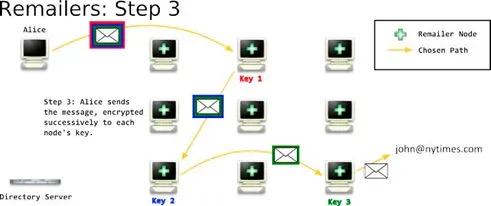
Structure diagram of Type II remailer
Early remailers simply forwarded information while concealing the sender's identity, whereas later protocols (such as the popular Mixmaster remailer) relied on decentralized nodes to distribute fixed-size encrypted data blocks through a P2P network. The architecture of Bitcoin is very similar to that of remailers, except that its nodes transmit transaction data rather than messages. In 1997, Tim May, the founder of crypto-anarchism, even proposed a digital currency based on remailers.
As the main developer, node operator, and primary maintainer of Mixmaster, Len was an authoritative expert in remailer technology. He also implemented similar technologies as a systems engineer and security architect in the Anonymizer privacy protection project.
Remailers are not only a direct precursor to Bitcoin technology but also the foundation of its intellectual history. In the article "Why Remailers," Finney argued that remailers are the basis of an anonymous digital economy.
Remailers are the "foundation layer" of this intellectual edifice—they give us the ability to exchange messages privately without exposing our true identities. In this way, we can transact, present credentials, and reach agreements without worrying about government or corporate databases tracking our every move.
One of the visions of the cypherpunks includes the ability to transact anonymously, using "digital cash."… This is another area where anonymous mail plays an important role.
The operators of remailers were among the first to recognize the demand for cryptocurrencies: due to the lack of anonymous payment methods, remailers had to be operated at the operators' own expense. This led to scalability issues and made spam and abuse commonplace. Because of this, many fundamental concepts of cryptocurrencies stem from the need to create an abuse-resistant, profit-driven remailer:
● In 1994, Finney proposed that remailers could be monetized through anonymous "coins" and "cash tokens."
● The first discussions of smart contracts occurred in the context of preventing remailer abuse. Nick Szabo's prescient paper on smart contracts published in 1997 specifically mentioned Mixmaster.
● Ian Goldberg and Ryan Lackey (two important figures known to Len) were key players in the remailer community, and they developed an unfinished cryptocurrency called HINDE in 1998. Ian later created several early electronic cash clients, while Ryan became the Chief Security Officer of Tezos.
Thus, in Satoshi's second post about Bitcoin, he mentioned that "paying to send emails" was the first practical use case for Bitcoin.
Initially, it could be used for almost free proof-of-work applications.
It could already be used for paying to send emails. The sending dialog box is resizable, and you can enter messages of any length.
Adam Back
In the small remailer community, Len also intersected with Adam Back, the CEO of Blockstream—the first person to communicate with Satoshi.
Back's interest in cryptocurrencies stemmed from operating remailers; he invented the HashCash proof-of-work system for remailer operators to combat spam and DDoS attacks. Satoshi later used HashCash as the basis for Bitcoin mining.
We know that Len worked directly with Back, who is listed as a contributor to a research paper by Len and a Mixmaster memo. They both participated in multiple OpenPGP implementation projects and were interconnected in each other's PGP web of trust.
Interestingly, Back himself has hinted that Satoshi might be a remailer developer, pointing out that these developers "practice their own technology" by participating in cryptographic protocol discussions in a pseudonymous manner. Unlike many of the cypherpunk figures discussed, we know that Len made extensive contributions to the cypherpunk mailing list pseudonymously through remailers.
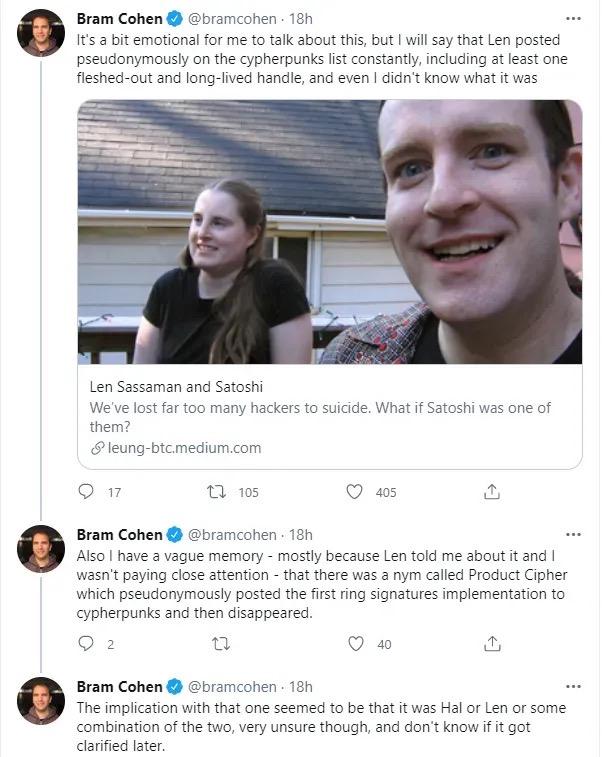
Chaum and COSIC
After graduating from high school, Len worked to support his family and never had the opportunity to attend university. However, in 2004, he successfully landed his "dream job" as a researcher and PhD candidate in the Computer Security and Industrial Cryptography research group (COSIC) at K.U. Leuven in Belgium.

At COSIC, Len's PhD advisor was David Chaum, the "father of digital currency." While Chaum laid the groundwork for the entire cypherpunk movement and all cryptocurrencies, few can claim to have worked directly with him.
Some of Chaum's significant achievements include:
● Inventing cryptocurrency in the 1983 paper "Blind Signatures for Untraceable Payments."
● Inventing blockchain in his 1982 doctoral thesis, which described all the elements of the blockchain in the Bitcoin white paper, except for one.
● Founding the first electronic cash system, Digicash, where anonymous payments between digital avatars were its core vision.
“[Chaum] is at the center of what seems to be an unstoppable movement—the digitization of currency… The unknown variable in the era of digital currency is anonymity, and David Chaum believes that without anonymity, we will be in trouble.”
Although Digicash failed (partly due to reliance on centralized systems), Chaum hoped to create a second digital currency that could provide both anonymity and practicality.
While many viewed its failure as evidence that digital cash was unfeasible, Satoshi defended the "old Chaum currency" while acknowledging the troubles caused by centralization.
Many people automatically view electronic money as a hopeless endeavor because all the related companies have failed since the 1990s. I hope it is clear that those systems failed solely because of their centralized nature.
Len's Research
Len worked at COSIC in Belgium until his death in 2011. During this time, he accumulated 45 publications and held 20 conference committee positions, achieving remarkable results.
Len's research focused on developing privacy-enhancing protocols with "real-world applicability" and writing practical code. His main project was Pynchon Gate, developed in collaboration with Bram Cohen, which is an evolved version of remailer technology that enables pseudonymous information retrieval through a distributed node network without trusting third parties.
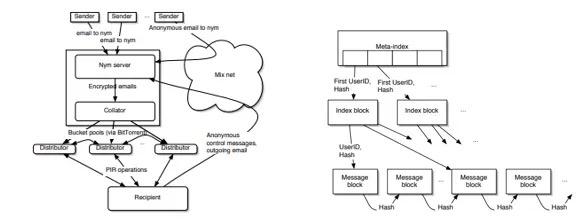
Pynchon Gate with Meta Index + Bucket Pool Architecture
This project is closely related to Bitcoin—as the research on Pynchon Gate progressed, Len gradually shifted his focus to solving the Byzantine problem, one of the major obstacles for early P2P networks.
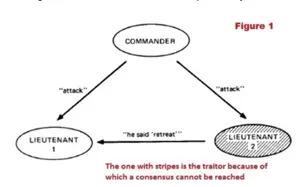
Illustration of the Byzantine Problem
In the context of distributed computing, Byzantine fault tolerance refers to the ability of a network to remain functional even when nodes are compromised or unreliable. The Byzantine problem is one of the biggest challenges that need to be solved to ensure that cryptocurrency systems can operate securely and decentralized without double spending or trusting third parties. Satoshi's most important innovation was introducing a "triple-entry" accounting system through the blockchain proposed by Chaum, successfully addressing this issue.
During the development of Bitcoin from 2008 to 2010, Len became increasingly active in the field of financial cryptography. He joined the International Financial Cryptography Association, gave talks at the Financial Cryptography and Data Conference, and served as a committee member. This conference was founded by early advocates of digital cash, Robert Hettinga, and digital cash was one of the main topics of discussion at the conference.
Satoshi as a Scholar
Many clues suggest that Satoshi may have been working in academia during the development of Bitcoin, a view supported by Gavin Andersen, the founder of the Bitcoin Foundation.
"I think he is an academic, possibly a postdoctoral researcher, or a professor who doesn't want to draw attention to himself."
Satoshi's code contributions and comments significantly increased during summer and winter holidays but noticeably decreased during late spring and year-end exam periods, which aligns with the situation where scholars have more time during holidays and are busy with exams or grading at the end of the term.
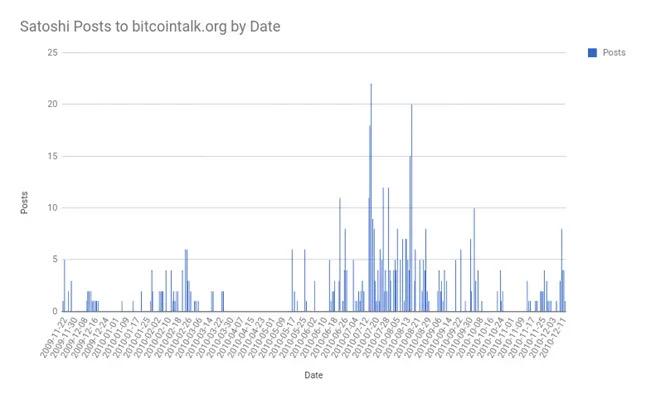
The unique construction of Bitcoin's code also indicates that Satoshi had an academic background. The code has been described as "excellent but not rigorous," lacking conventional software development practices like unit testing, yet showcasing cutting-edge security architecture and a deep understanding of academic cryptography and economics.
This person has a profound understanding of cryptography… they have read academic papers, possess sharp intelligence, and combine these concepts in truly innovative ways.
When renowned security researcher Dan Kaminsky first reviewed Satoshi's code, he attempted to penetrate it using nine different vulnerabilities, but to his surprise, Satoshi had already anticipated and patched these issues.
"I designed beautiful vulnerabilities, but every time I attacked the code, there was a line in the code addressing that issue… I had never seen anything like it."
This may indicate that Satoshi shared similar information security experiences and expertise with Kaminsky. Coincidentally, Len and Kaminsky co-authored and published a paper demonstrating methods to attack public key infrastructure.
Additionally, the Bitcoin white paper was published in a format uncommon on the cypherpunk mailing list—it is a LaTeX formatted research paper with academic features such as an abstract, conclusion, and MLA citation format. This stands in stark contrast to the irregular blog post style of other proposals like Bitgold and b-money.
Satoshi in Europe
Since COSIC is located in Leuven, Len lived in Belgium during the development of Bitcoin. This is significant because some facts suggest that Satoshi may also have been in Europe, which was a major focus of early investigations by The New Yorker.
Satoshi's writing style features typical British English spelling and terminology, such as "bloody difficult," "flat," "maths," "grey," and the date format dd/mm/yyyy. However, Satoshi also mentioned the euro instead of the pound.
The genesis block of Bitcoin also contains a headline from that day's Times ("The Times 03/Jan/2009 Chancellor on brink of second bailout for banks"). This headline specifically refers to the printed version of that day, and the newspaper was only distributed in the UK and Europe. In 2009, The Times was among the top ten newspapers in Belgium and was widely used by scholars and researchers due to its extensive availability in libraries and detailed indexing system.

These clues present a paradox: they imply that Satoshi is European, but the skills and connections required for Bitcoin are more likely to belong to an American. Most meetings and gatherings in the cypherpunk community were concentrated in the United States, particularly in San Francisco, so many key figures were from the U.S. The job opportunities to gain cutting-edge information security and cryptographic experience were also mostly located in the U.S.
Interestingly, despite Len being American, the British English he used was identical to Satoshi's.
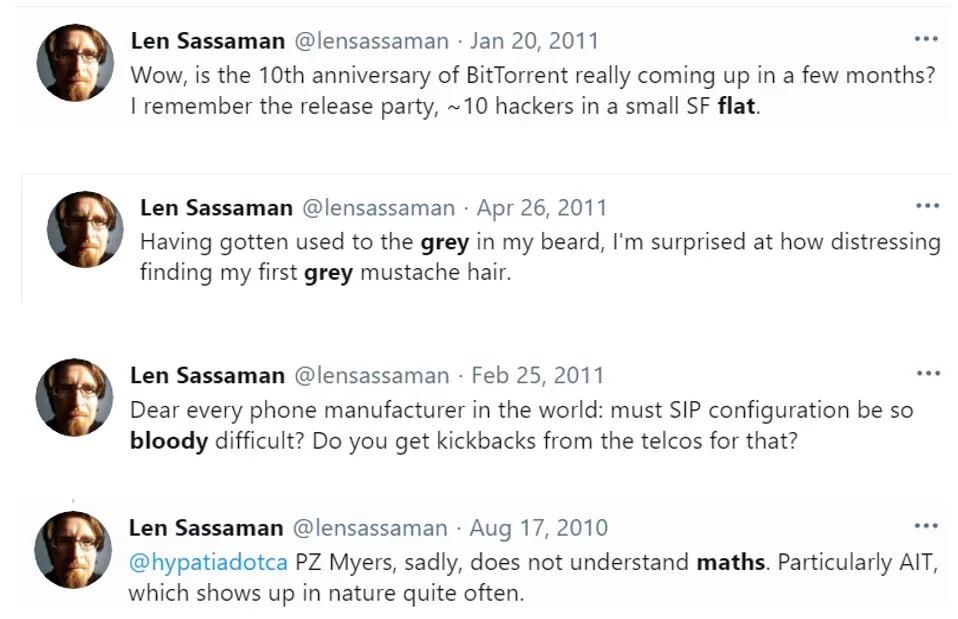
An analysis of Satoshi's posting history suggests that he was a European "night owl," typically engaging in Bitcoin development after completing work or studies during the day. At one point, Satoshi mentioned that the increase in mining difficulty occurred "yesterday," which would not make sense if he lived in the U.S.
Assuming Satoshi's life was not solely Bitcoin, he would leave his home computer during the day for work or study… If Satoshi lived in the British Summer Time (BST) timezone, he would mostly work at night, often until the early morning.
When we look at Len's tweet history, we can see that the times Satoshi posted and submitted code closely align with Len's late-night activity.
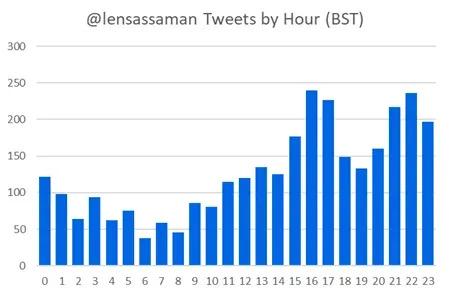
P2P Networks
While Bitcoin is not the first cryptocurrency, it is the first cryptocurrency based on a fully P2P distributed network. Satoshi emphasized this point when he first mentioned Bitcoin:
I have been working on a new electronic cash system that is completely peer-to-peer, with no trusted third party.
Dan Kaminsky stated that to build Bitcoin, Satoshi must have "understood economics, cryptography, and P2P networks," and Len had unusually early exposure and deep understanding of all three and their applications in digital currency.

Bram and Len in an interview at CodeCon
During his time in San Francisco, Len lived and collaborated with Bram Cohen, the creator of the P2P protocol BitTorrent. Between 2000 and 2002, Bram developed a revolutionary P2P network called MojoNation, which used "Mojo tokens" as digital currency, making it one of the earliest publicly released digital currencies.

In the P2P economy of MojoNation, tokens could be used to exchange file storage, with files encrypted and encoded into "blocks," uploaded to a distributed node network, and recorded on a public ledger, resembling Bitcoin's distributed double-entry accounting system. Mojo was not just an internal accounting token but a complete currency—exchangeable for dollars and vice versa. Some of the earliest discussions about token economies revolved around the mechanisms of Mojo tokens.
A Mojo represents a part of the overall capacity of the current system. If you work for me now, I will give you points, and when the network grows larger in the future, these points will represent a part of a larger pie, thus their value will increase when you use them.
Satoshi discussed token economies in a similar manner:
It has the potential to form a positive feedback loop; as the number of users increases, the value rises, which may attract more users to take advantage of this growing value.
Despite MojoNation's foresight, its economic system quickly collapsed due to hyperinflation. Satoshi deliberately designed Bitcoin to avoid this fate, ensuring its stability through a built-in deflationary mechanism and not relying on a centralized "minting" server.

In 2001, Bram launched BitTorrent. As a P2P alternative to Napster, BitTorrent foreshadowed Bitcoin's own distributed node topology, consensus system, and incentive mechanisms at the protocol layer. BitTorrent not only innovated technologically over networks like Gnutella but also advanced design through economic incentives and game theory.
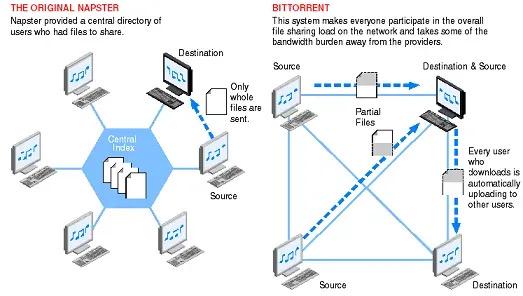
Comparison of BitTorrent design with Napster
Presciently, Len once told Bram, "BitTorrent will make you more famous than [Napster founder] Sean Fanning." Satoshi later referenced Napster to explain why a completely decentralized network was necessary.
Governments are good at cutting off the "head" of centralized networks like Napster, but pure P2P networks like Gnutella and Tor seem to be able to sustain themselves.
Coincidentally, both Len and Roger Dingledine, the founder of Tor, were involved in developing the Mixminion remailer protocol, and they demonstrated together at the Black Hat conference, co-founding the HotPETS conference.
In 2002, Len and Bram co-founded a conference called CodeCon, focused on "projects with practical, actionable code." At CodeCon 2005, Finney demonstrated "Reusable Proof of Work" (RPOW) through a modified BitTorrent client, which could send P2P digital currency. One commentator described it as:
…the world's first transparent server that could facilitate a distributed, collaborative RPOW server world.
Digital currency was a significant theme of the first CodeCon, which also showcased Adam Back's HashCash and Zooko's demonstration of Mnet, a fully open-source and decentralized successor to MojoNation. MojoNation did not rely on a single company and could be independently audited, both of which were features Satoshi deemed crucial.
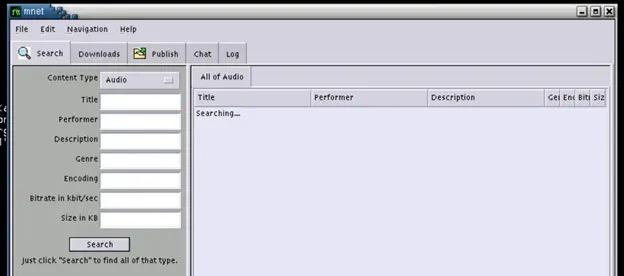
Screenshot of the Mnet client
Zooko Wilcox and Jim McCoy, co-founders of MojoNation, also have significant influence in the cryptocurrency space; Zooko was one of Satoshi's early collaborators and worked for David Chaum's Digicash. When Bitcoin v0.1 was released, Satoshi linked to Zooko's blog on Bitcoin.org. Zooko later founded the privacy-focused cryptocurrency Zcash and proposed the much-discussed "Zooko Triangle" framework.
_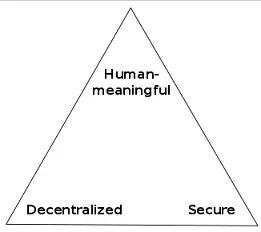
_
The "Zooko Triangle" is a trilemma regarding three ideal characteristics of participant names in network protocols.
McCoy is also a major influencer in the cryptocurrency space, with Ryan Selkis of Digital Currency Group even stating that he believes McCoy might be Satoshi.
Hacker Activism
Even by the standards of the cypherpunk community, both Len and Satoshi exhibited particularly strong ideological beliefs and a firm commitment to open knowledge.
I hope you won't always talk about me… perhaps the focus can be on open-source projects, giving more recognition to the developers and contributors.
Satoshi's "hacker activism" approach to distributing Bitcoin through a free, open-source grassroots project stands in stark contrast to their predecessors, such as Chaum, Stefan Brand, eCash, and others, who took a completely different approach: applying for patents, founding closed-source venture capital firms, and attempting to drive adoption through corporate partnerships.
This method mirrors Len's extensive contributions to open-source projects, such as his work on PGP, Mixmaster, GNU Privacy Guard, and his volunteer experiences in organizations like the Shmoo Group.

In response to this story, Bram noted that Len had a preference for anonymous publishing.
Satoshi mentioned their ideological leanings in several statements, indicating that Bitcoin's appeal to libertarians was "very attractive" and that it could "win a major battle in the arms race, gaining years of new territory for freedom."
Len was equally passionate about defending open knowledge and technological progress, resisting interference from corporations and governments.
The pursuit of knowledge is a fundamental part of being human. Any form of prior restraint, I believe, is an infringement on our freedom of thought and consciousness. Therefore, I not only hope we can avoid overly restrictive reactive legislation… I also do not want to see anyone establish frameworks that could be misused.
Conclusion
Just as Satoshi created Bitcoin behind a pseudonym, Len was, to some extent, forced to live behind his own mask. Following an incident in 2006, Len began to suffer from increasingly severe non-epileptic seizures and functional neurological issues, exacerbating the depression he had been battling since his teenage years.
As a victim of stigma, Len "felt he had to maintain this facade of being superhuman," and he was "very afraid" that the deterioration of his health would end his work and disappoint those he cared about.
Despite these challenges, Len continued to work until a few months before his death, writing papers and even giving talks at Dartmouth College. Unfortunately, he successfully concealed the severity of his condition from almost everyone.
"Very few people knew things had gotten to this point… One phrase I repeatedly heard was, 'We never knew; he seemed to be doing fine.'"
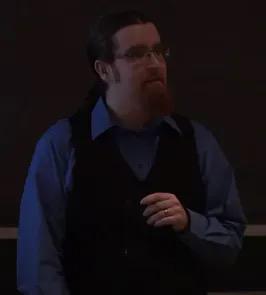
Len speaking at Dartmouth College shortly before his death.
Just as Len built upon the ideas of his predecessors, we feel his commitment to constructing things that could transcend his own existence, which is one of the reasons for his dedication to open source and open knowledge.
"This is our legacy, this research, these ideas, are leading us toward knowledge that has never existed in human history. We will pass these on to future generations. We must ensure we are not cornered into a position where we cannot distribute research to others, ensuring that this research is not locked away in the vaults of intellectual property lawyers."
Len passed away in 2011, which was a tremendous loss for the cypherpunk and the entire tech community, as reflected in the numerous tributes and remembrances that followed. One particular post that impressed me was by a user named "pablos08" on Hacker News.
"I became friends with Len, once a fellow conspirator in the cypherpunk movement, which at that time was a wild frontier. We reimagined our world, filled with cryptographic systems that would defend the freedoms we cherish through mathematics. Anonymous remailers were used to protect speech from the threat of retaliation; onion routers ensured that no one could censor the internet; digital cash supported an extremely free economy. We designed plans to decentralize and distribute everything.
We imagined complex and obscure threats, targeting problems we might face one day; we built future protocols to withstand these threats. All of this was a highly academic geek utopian exercise. And I usually kept it that way, but Len wanted to be truly involved.
Cryptopunks write code."
免责声明:本文章仅代表作者个人观点,不代表本平台的立场和观点。本文章仅供信息分享,不构成对任何人的任何投资建议。用户与作者之间的任何争议,与本平台无关。如网页中刊载的文章或图片涉及侵权,请提供相关的权利证明和身份证明发送邮件到support@aicoin.com,本平台相关工作人员将会进行核查。




